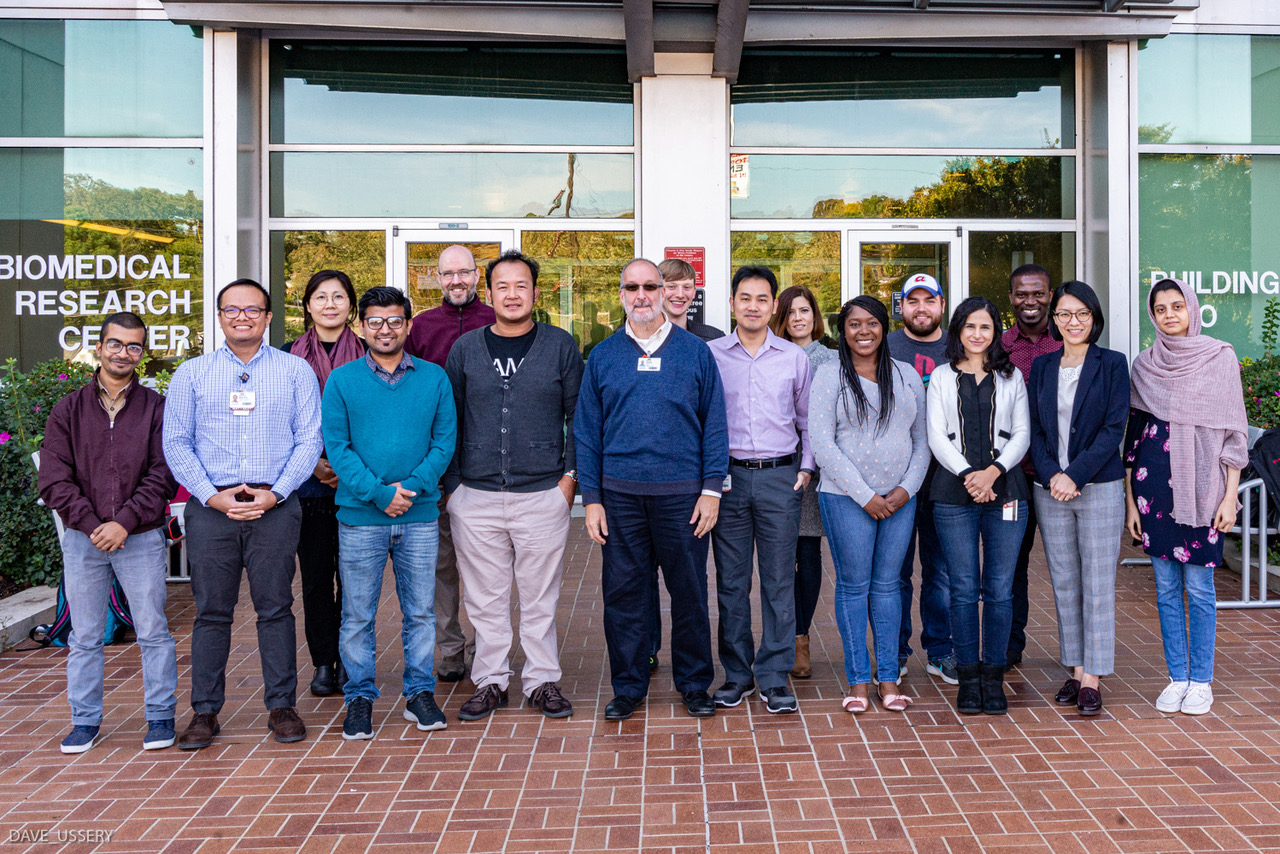View Larger Image

The UAMS Arkansas Center for Genomic Epidemiology & Medicine (ArC-GEM) team.
UAMS Researchers Have COVID-19’s ‘Fingerprint’
| Coronavirus Disease 2019 (COVID-19) has the attention of biomedical researchers across the globe, including at UAMS.
Researchers at the UAMS Arkansas Center for Genomic Epidemiology & Medicine (ArC-GEM) are applying their comparative genomic analysis and sequencing prowess to the disease. The ArC-GEM team has also studied the Ebola virus, Zika virus, and the mumps outbreak in Northwest Arkansas.
Under the direction of David Ussery, Ph.D., ArC-GEM is known for its groundbreaking research, particularly with portable gene sequencing devices that can rapidly diagnose pathogenic diseases like COVID-19. Ussery also has a national profile, working with U.S. health leaders to address hurdles that prevent use of the portable devices in real-world settings.
With its sequencing expertise and computing power, the team has a unique ability to dig into coronavirus’ makeup. One of Ussery’s Ph.D. students, Visanu Wanchai, has been mining genomic sequences of coronaviruses from the National Center for Biotechnology Information (NCBI) and other sources. The sequence of coronavirus samples collected from all over the world are stored in databases, including NCBI, which is part of the U.S. National Library of Medicine, a branch of the National Institutes of Health.
Wanchai has created a dendrogram, which is akin to a family tree, for a wide-ranging set of 81 coronaviruses, including samples of COVID-19 from patients in the United States and other countries.
Wanchai downloaded more than 30,000 coronavirus genomes, checked them for genome quality, and sorted them into major groups, representing all of the major Coronavirus clades (groups that evolved from a common ancestor). He produced the dendrogram after “cleaning” the data, which meant discarding about two-thirds of incomplete or mislabeled genomes. He was able to create the dendrogram in just hours, using high-throughput computing made possible by UAMS’ 2017 investment in a $3.5 million super computer.
“Only a few years ago, it would have taken months to analyze this data,” said Ussery, who holds the Helen Adams & Arkansas Research Alliance Endowed Chair in Biomedical Informatics.
Shown in seven PowerPoint slides, the dendrogram includes the date and country where the viruses were collected, as well as its human and animal hosts. It also includes the viruses’ family, genus and subgenus. The work provides a context for the coronaviruses that will inform efforts to monitor the virus and help with rapid detection going forward.
Ussery also noted that Wanchai’s dendrogram shows COVID-19 almost certainly came from bats, confirming other scientists’ findings that debunk conspiracy theories about its origin. This image taken from the dendrogram shows that the closest relative to COVID-19’s human strain comes from bats. It also shows variations of the coronavirus that cause the common cold.
“We’re looking at the big picture here, not just COVID-19,” Ussery said. “The COVID-19 that we see in the United States and in South Korea and Italy – it’s all the same virus, and you can tell that from the genome sequence – its fingerprint. There are only one or two nucleotides that have changed so far in the outbreak.”
In 2019, using hand-held genetic sequencing flow-cell devices, Ussery’s team was the first to demonstrate a new technique that allowed detection of six different human RNA viruses, mixed in the same sample, by directly sequencing the RNA viral genomes. It marked an important step toward rapid diagnosis of viruses in real-world settings, including rural areas. While a significant proof of principal, the early-stage research will need more development before health workers can take human tissue samples and use the devices to diagnose viruses.
“Currently, large amounts of virus are needed, but in principle, since this technology is based on single-molecule sequencing, only tiny amounts from a clinical sample might be enough to be detected,” Ussery said. “The portability and low cost makes this an exciting possibility for rural health settings.”
One of the primary roadblocks is a lack of quality and safety standards for using the devices in an actual outbreak. Ussery recently presented on the issue to the National Institute of Standards and Technology and the U.S. Food and Drug Administration. A summary of his presentation appears in a report in the February 2020 journal Biologicals.
“There is a need for being able to rapidly go from a sequence to the nearest neighbor in the sequence databases, and for being able to interpret what the organism is,” Ussery said. “There are many ways that this can go wrong, and it’s important to have a reliable, robust, ‘idiot-proof’ and simple method for quickly knowing what the virus is, and to be able to keep track and monitor outbreaks.”
Established just three years ago, UAMS ArC-GEM’s team has already published more than 100 articles on its work, Ussery said. Congress’ recent approval of more than $8 billion to address COVID-19, including $3 billion for research, is an opportunity for the ArC-GEM team, he said. Additional funding would allow the team to further its development of tools for monitoring and tracking pathogen outbreaks.
